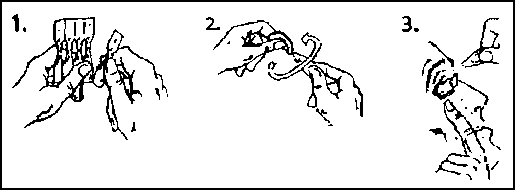Celluvisc 0.5%W/V Eye Drops Solution Unit Dose
3. How to use CELLUVISC

4. Possible side effects
PACKAGE LEAFLET: INFORMATION FOR THE USER CELLUVISC® 0.5% w/v, eye drops, solution, unit dose (carmellose sodium)
Your medicine is available as the above name but will be referred to as CELLUVISC throughout this leaflet.
Read all of this leaflet carefully before you start using this medicine because it contains important information for you.
This medicine is available without prescription from pharmacies. Always use this medicine exactly as described in this leaflet or as your pharmacist or nurse has told you.
• Keep this leaflet. You may need to read it again.
• Ask your pharmacist if you need more information or advice.
• If you get any side effects, talk to your doctor, pharmacist or nurse. This includes any possible side effects not listed in this leaflet. See section 4.
• You must talk to a doctor if you do not feel better or if you feel worse.
What is in this leaflet
1. What CELLUVISC is and what it is used for
2. What you need to know before you use CELLUVISC
3. How to use CELLUVISC
4. Possible side effects
5. How to store CELLUVISC
6. Contents of the pack and other information
1. What CELLUVISC is and what it is used for
CELLUVISC is a substitute for tears, and contains the lubricant called carmellose sodium. It is used for the treatment of the symptoms of dry eye (such as soreness, burning, irritation or dryness) caused by you not producing enough tears to keep the eye wet.
2. What you need to know before you use CELLUVISC Do not use CELLUVISC
• If you are hypersensitive (allergic) to carmellose sodium or any of the other ingredients of this medicine (listed in section 6).
Warnings and precautions
• If irritation, pain, redness or changes in vision occur or if you feel your condition is getting worse, stop taking this medicine and consult your doctor or pharmacist.
Other medicines and CELLUVISC
Please tell your doctor or pharmacist if you are using, have recently used or might use any other medicines, including medicines obtained without a prescription.
If you are using other eye drops, leave at least 15 minutes between putting in the other drops and CELLUVISC.
Pregnancy and breast-feeding
You can use CELLUVISC if you are pregnant and when you are breast-feeding.
Driving and using machines
CELLUVISC may cause temporary blurring of vision. If you do experience temporary blurring, do not drive or use machines until your sight is clear.
Read all the information in this leaflet before using CELLUVISC. If you are unsure about anything, discuss it with your doctor, nurse or pharmacist.
Always use this medicine exactly as described in this leaflet or as your doctor, pharmacist or nurse has told you. Check with your doctor, pharmacist or nurse if you are not sure.
The recommended dose is 1-2 drops of CELLUVISC in the affected eye/each affected eye, 4 times a day or as often as needed.
You do not need to remove contact lenses before using CELLUVISC.
Make sure that the single-dose container is intact before use. The solution should be used immediately after opening. To avoid contamination or possible eye injury, do not let the open-end of the single-dose container touch your eye or anything else.
Wash your hands before use.
1. Tear one single-dose container from the strip.
2. Hold the single-dose container upright (with the top uppermost) and twist off the top.
3. Gently pull down the lower eyelid to form a pocket. Turn the single-dose container upside down and squeeze it to release one drop into each eye. Blink your eyes a few times.
Do not re-use the single-dose container even if there is some solution left. It is most important that you throw it away and do not keep it.
If you use more CELLUVISC than you should
It will not cause you any harm. If you are worried, talk to your doctor or pharmacist.
If you forget to use CELLUVISC®
Use a single drop in each eye that needs treatment as soon as you remember, and then go back to your regular routine. Do not use a large number of drops to make up for forgetting to put drops in your eye or eyes earlier.
If you have any further questions on the use of this medicine, ask your doctor, pharmacist or nurse.
Like all medicines, this medicine can cause side effects, although not everybody gets them.
The side effects are classified into the following categories, depending on how often they occur:
|
Very common |
may affect more than 1 in 10 people |
|
Common |
may affect up to 1 in 10 people |
|
Uncommon |
may affect up to 1 in 100 people |
|
Rare |
may affect up to 1 in 1,000 people |
|
Very rare |
may affect up to 1 in 10,000 people |
|
Not known |
frequency cannot be estimated from the available data |